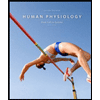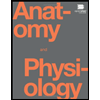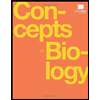
ACTIVE-LEARNING WRKBK FOR HUM ANAT & PHY
2nd Edition
ISBN: 9780135643303
Author: AMERMAN
Publisher: PEARSON
expand_more
expand_more
format_list_bulleted
Textbook Question
thumb_up100%
Chapter 25.3, Problem 2QC
How is sodium ion concentration regulated?
Expert Solution & Answer
Want to see the full answer?
Check out a sample textbook solution
Students have asked these similar questions
"Which of the following about transposable elements (TEs) is false?"
RNA transposons move using an RNA intermediate.
DNA transposons make up 3% of the human genome but are disruptive.
Genes can move within the same chromosome via TEs.
The Drosophila P element can only move in germline cells.
Can you explain each answer choices pleae?
What will control the rate of bioremediation of petroleum? (Choose all correct answers)
The availability of the petroleum
The temperature of the water
The availability of oxygen
The percent of the population that has degraded petroleum in the past
Which of the following would lead to a false negative result in a sandwich ELISA (the lab manual refers to this as a direct ELISA- also known as search for antigen)? Mark all correct answers.
antibody was non-specific and bound to something other than the antigen of interest.
too short of a duration when incubating the reagents in the plate.
If there are multiple strains of the pathogen of interest and the antibody does not recognize one of the strains.
Did not sample the correct bodily fluid/area to detect the antigen
concentration of antigen was too low to detect in the patient sample.
inadequate washing was performed after the enzyme linked antibody was allowed to bind.
substrate was exposed to too much light
reusing a pipette that was used to pipette a positive sample.
Chapter 25 Solutions
ACTIVE-LEARNING WRKBK FOR HUM ANAT & PHY
Ch. 25.1 - 1. What is a body fluid?
Ch. 25.1 - 2. What is balance with respect to body fluids?
Ch. 25.1 - How does an electrolyte differ from a...Ch. 25.1 - What is electrolyte balance?Ch. 25.1 - 5. How do acids and bases differ?
Ch. 25.1 - 6. Which pH values are acidic, basic, and...Ch. 25.2 - Prob. 1QCCh. 25.2 - What factors affect total body water?Ch. 25.2 - 3. Where are the intracellular and extracellular...Ch. 25.2 - Prob. 4QC
Ch. 25.2 - Prob. 5QCCh. 25.2 - Prob. 6QCCh. 25.2 - Prob. 7QCCh. 25.2 - How is thirst stimulated?Ch. 25.2 - How are fluids lost from the body?Ch. 25.2 - 10. What are the water requirements for an...Ch. 25.2 - 11. What is the role of ADH in fluid balance?
Ch. 25.2 - How is ADH secretion stimulated?Ch. 25.2 - How does dehydration affect the volume of the...Ch. 25.2 - Prob. 14QCCh. 25.2 - 15. How do dehydration and overhydration differ...Ch. 25.3 - What are the main roles of sodium ions in the...Ch. 25.3 - How is sodium ion concentration regulated?Ch. 25.3 - Prob. 3QCCh. 25.3 - Prob. 4QCCh. 25.3 - 5. How is the concentration of potassium ions in...Ch. 25.3 - 6. What happens to the resting membrane potential...Ch. 25.3 - Prob. 7QCCh. 25.3 - Prob. 8QCCh. 25.3 - Prob. 9QCCh. 25.3 - Prob. 10QCCh. 25.3 - 11. How is chloride ion reabsorption in the...Ch. 25.3 - 12. How is the concentration of magnesium ions in...Ch. 25.4 - What are the major sources of acids for the body?Ch. 25.4 - Prob. 2QCCh. 25.4 - Prob. 3QCCh. 25.4 - Prob. 4QCCh. 25.4 - Prob. 5QCCh. 25.4 - Prob. 6QCCh. 25.4 - Prob. 7QCCh. 25.4 - Prob. 8QCCh. 25.4 - How do metabolic acidosis and respiratory acidosis...Ch. 25.4 - Prob. 10QCCh. 25.4 - Prob. 11QCCh. 25.5 - Prob. 1QCCh. 25.5 - Prob. 2QCCh. 25 - Prob. 1CYRCh. 25 - 2. How does an electrolyte differ from a...Ch. 25 - Prob. 3CYRCh. 25 - Prob. 4CYRCh. 25 - Prob. 5CYRCh. 25 - Prob. 6CYRCh. 25 - Which of the following is false with respect to...Ch. 25 - Prob. 8CYRCh. 25 - Prob. 9CYRCh. 25 - Prob. 10CYRCh. 25 - Prob. 11CYRCh. 25 - Prob. 12CYRCh. 25 - Prob. 13CYRCh. 25 - Prob. 14CYRCh. 25 - 15. Which of the following mechanisms is/are used...Ch. 25 - Mark the following statements as true or false. If...Ch. 25 - Prob. 17CYRCh. 25 - 18. How does angiotensin-II help to restore fluid...Ch. 25 - Prob. 1CYUCh. 25 - Prob. 2CYUCh. 25 - Prob. 3CYUCh. 25 - Prob. 4CYUCh. 25 - Prob. 1AYKACh. 25 - Prob. 2AYKACh. 25 - Prob. 3AYKACh. 25 - Prob. 4AYKACh. 25 - Prob. 5AYKB
Knowledge Booster
Learn more about
Need a deep-dive on the concept behind this application? Look no further. Learn more about this topic, biology and related others by exploring similar questions and additional content below.Similar questions
- S. +1269 pts /1500 © Macmillan Learning 0 Resources Solution Penalized Feedback Try Again Draw the final product with stereochemistry and lone pairs. The leaving group has been pre-drawn for your convenience. +100 +100 : 0: + H,C- :0: : 0 0 : +100 +94 possible ✓ +100 K Attemparrow_forward+1269 pts /1500 © Macmillan Learning t/1188d950-dd73-11e0-9572-0800200c9a66/3045511b-267e-4a00-86ca-85dbc62ecb4e/6ac3a0c9-... a □ 出 All Bookmarks Due: Mon, May 26 Resources Solution Penalized Feedback Try Again KX Attempt 3 Draw the final product with stereochemistry and lone pairs. The leaving group has been pre-drawn for your convenience. :0: + нс H,C- :0: : 0:arrow_forwards. +1169 pts /1500 © Macmillan Learning 0 Resources Hint Submit Answer Step 3: This tertiary carbocation intermediate readily undergoes elimination with any weak base to form two possible products. + + H :0: H +94 possible 3a) Draw the minor organic product of elimination. Select Draw Templates More +100 +95 possible # C Major product + Minor product 3b) Draw the major organic product of elimination. Erase Select Draw Templates More C Erasearrow_forward
- Explain the Science & Society on (with links and pictures): ---- Question down below Discuss the ethical, medical, and societal implications of using advanced genetic techniques?arrow_forwardExplain the Disease Mechanism & Impact on (with links and pictures): What causes Leigh Syndrome and why it's so deadly. Which cellular functions, organelles (especially mitochondria), and macromolecules are involved.arrow_forwardExplain the Disease Mechanism & Impact on (with links and pictures): What's going wrong inside the cell and the effects on the human body. Describe metabolism with an emphasis on cellular respiration.arrow_forward
- Explain the Disease Mechanism & Impact on (with links and pictures):arrow_forwardExplain the Science & Society on (with links and pictures): Discuss the ethical, medical, and societal implications of using advanced genetic techniques.arrow_forward↑ LED Tt O Tt e 0 ✓ B > FLORES DIology Second Semester Review 7. Chi Square Analysis: wild dumpy male x ebony wild female F1: All wild wild F2: 142 wild wild males 52 wild ebony males 46 dumpy wild males 17 dumpy ebony males 151 wild wild females 47 wild ebony females 51 dumpy wild females 8 dumpy ebony females What pattern of inheritance is observed for body color? Autosomal recessive Autosomal dominant Sex-linked recessive Sex-linked dominant What are the genotypes of the parents in the P generation? a. XBYdd x XbXbDD b. Bbdd x bbDd c. BBdd x bbDD d. BBX Y x bbXDY How many flies in the F2 generation would you expect to express the dumpy wild phenotype? a. 289.125 b. 97 c. 96.375 d. 293arrow_forward
- 4. This question focuses on entrainment. a. What is entrainment? b. What environmental cues are involved in entrainment, and which one is most influential? c. Why is entrainment necessary? d. Assuming that a flash of darkness is an effective zeitgeber, what impact on circadian rhythms would you expect to result from an event such as the 2024 solar eclipse (assume it was viewed from Carbondale IL, where totality occurred at about 2 pm)? Explain your reasoning. You may wish to consult this phase response diagram. Phase Shift (Hours) Delay Zone Advance Zone Dawn Mid-day Dusk Night Dawn Time of Light Stimulus e. Finally, give a real-world example of how knowledge of circadian rhythms and entrainment has implications for human health and wellbeing or conservation biology. This example could be from your reading or from things discussed in class.arrow_forwardGenerate one question that requires a Punnet Squre to solve the question. Then show how you calculate the possibilities of genotype and phenotypearrow_forwardBriefly state the physical meaning of the electrocapillary equation (Lippman equation).arrow_forward
arrow_back_ios
SEE MORE QUESTIONS
arrow_forward_ios
Recommended textbooks for you
 Human Physiology: From Cells to Systems (MindTap ...BiologyISBN:9781285866932Author:Lauralee SherwoodPublisher:Cengage Learning
Human Physiology: From Cells to Systems (MindTap ...BiologyISBN:9781285866932Author:Lauralee SherwoodPublisher:Cengage Learning Anatomy & PhysiologyBiologyISBN:9781938168130Author:Kelly A. Young, James A. Wise, Peter DeSaix, Dean H. Kruse, Brandon Poe, Eddie Johnson, Jody E. Johnson, Oksana Korol, J. Gordon Betts, Mark WomblePublisher:OpenStax College
Anatomy & PhysiologyBiologyISBN:9781938168130Author:Kelly A. Young, James A. Wise, Peter DeSaix, Dean H. Kruse, Brandon Poe, Eddie Johnson, Jody E. Johnson, Oksana Korol, J. Gordon Betts, Mark WomblePublisher:OpenStax College Concepts of BiologyBiologyISBN:9781938168116Author:Samantha Fowler, Rebecca Roush, James WisePublisher:OpenStax College
Concepts of BiologyBiologyISBN:9781938168116Author:Samantha Fowler, Rebecca Roush, James WisePublisher:OpenStax College Human Biology (MindTap Course List)BiologyISBN:9781305112100Author:Cecie Starr, Beverly McMillanPublisher:Cengage Learning
Human Biology (MindTap Course List)BiologyISBN:9781305112100Author:Cecie Starr, Beverly McMillanPublisher:Cengage Learning

Human Physiology: From Cells to Systems (MindTap ...
Biology
ISBN:9781285866932
Author:Lauralee Sherwood
Publisher:Cengage Learning

Anatomy & Physiology
Biology
ISBN:9781938168130
Author:Kelly A. Young, James A. Wise, Peter DeSaix, Dean H. Kruse, Brandon Poe, Eddie Johnson, Jody E. Johnson, Oksana Korol, J. Gordon Betts, Mark Womble
Publisher:OpenStax College

Concepts of Biology
Biology
ISBN:9781938168116
Author:Samantha Fowler, Rebecca Roush, James Wise
Publisher:OpenStax College



Human Biology (MindTap Course List)
Biology
ISBN:9781305112100
Author:Cecie Starr, Beverly McMillan
Publisher:Cengage Learning
Haematology - Red Blood Cell Life Cycle; Author: Armando Hasudungan;https://www.youtube.com/watch?v=cATQFej6oAc;License: Standard youtube license